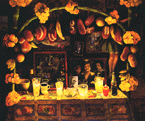| EC
|
At the beginning people thought that what I was doing was horrible but
there's a greater acceptance of it now. When I began I doubted that I would
ever be appreciated. People considered what I was doing to be vulgar-I was
looked on almost as a traitor to the way I'd been brought up. However, when I
had an exhibition at the Palacio de Bellas Artes in Mexico City in 1988 I was
sure that there would be a very negative reaction but I was surprised that so
many people identified with what I painted. People of my own group
generally liked it-much to my amazement. They looked at my work and said,
"Yes, things really are like that." They discovered beauty in things that they
had been trained to dismiss as ugly or vulgar. I was also gratified to see the
great number of visitors to my show from different social classes. Very rich
people as well as people like the guards or the maintenance staff of the
museum came and looked with real sympathy at what I'd done.
|
| EC
|
I don't know. I've always been a loner. I am self-trained and it never
seemed to me that I did things the normal way. Yes, I do feel, in general, a
part of a
"generation" of artists insofar as I'm confronting the same problems as
everyone else, not only in Mexico but in the world. I feel that everyone is
looking for some urgent reason to preserve a certain amount of optimism
about life in a moment when there's a real pessimism around. Insofar as
contemporary Mexican artists are concerned, I've been able to see a lot more
of their work since I've been living in New York and I realize that there are
tendencies and preoccupations in their art that we have in common. I am
surprised to see that there are so many parallels with my own work so there
must be things "in the air" that we're all concerned with. For example,
there's a definite trend to return to realism and a specific way of treating
objects and color that's similar in many of us. There's a rejection among us
of the canons of the preceding generation. We reject Europeanism in art. We
were told in school that we should imitate European art but we don't want to.
Abstraction is also something we reject, although there are marvelous
abstract artists. I feel something of a tension between us and the previous
generation. We're often attacked by the older artists as "folkloric" painters.
For example, if any of us paints a Virgin of Guadalupe, that's it.. .we re
immediately marked by these older artists as simple folklorists. My
principal idea has been to search out things in Mexican life-traditions and
customs that aren't moribund but are very much alive-things that are
regenerating themselves. I want to show that there really is a Mexican
reality today, one that's not coming to an end but rather is very much alive
and constantly regenerating itself. I go to Mexico twice each year and I'm
always seeing a continuation of what I'd observed before. This really has
nothing to do with nationalism because I believe that what I'm painting has
universal value.
|










